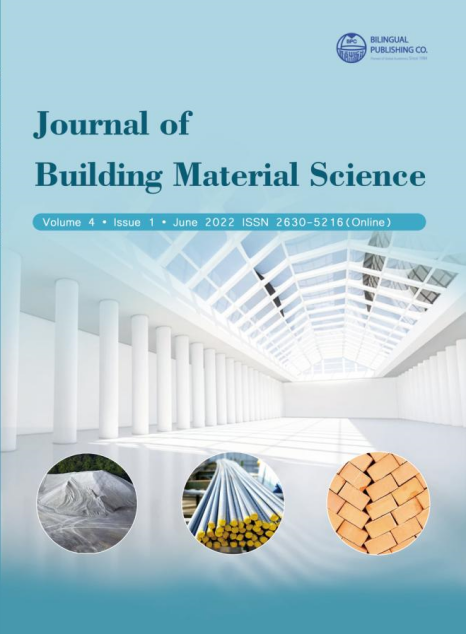
Analysis of Heat Transfer Phenomena inside Concrete Hollow Blocks
DOI:
https://doi.org/10.30564/jbms.v4i1.4500Abstract
During both hot and cold seasons, masonry walls play an important role in the thermal performance between the interior and the exterior of occupied spaces. It is thus essential to analyze the thermal behavior at the hollow block’s level in order to better understand the temperature and heat flux distribution in its structure and potentially limit as much as possible the heat transfer through the block. In this scope, this paper offers an experimental and numerical in-depth analysis of heat transfer phenomena inside a hollow block using a dedicated experimental setup including a well-insulated reference box and several thermocouples and fluxmeters distributed at the boundaries and inside the hollow block. The block was then numerically 3D modelled and simulated using COMSOL Multiphysics under the same conditions, properties, and dimensions as the experimentally tested block. The comparison between the numerical and experimental results provides very satisfactory results with relative difference of less than 4% for the computed thermal resistance.
Keywords:
Hollow block; Cavities; Thermophysical properties; Dynamic boundary conditions; 3D modellingReferences
[1] Energie, changement climatique et bâtiment en Méditerranée : étude nationale Liban - Plan-bleu : Environnement et développement en Méditerranée. https://planbleu.org/publications/energie-changement-climatique-et-batiment-en-mediterranee-etude-nationale-liban/
[2] del Coz Díaz, J.J., García Nieto, P.J., Domínguez Hernández, J., et al., 2010. A FEM comparative analysis of the thermal efficiency among floors made up of clay, concrete and lightweight concrete hollow blocks. Applied Thermal Engineering. 30(17), 2822-2826. DOI: https://doi.org/10.1016/j.applthermaleng.2010.07.024
[3] Ribeiro, R.S., Sousa, R.P.D., Amarilla, R.S.D., et al.,2021. Sound insulation of a hollow concrete blocks wall made with construction and demolition waste and wood-based panels as linings. Building Acoustics. 28(4), 423-442. DOI: https://doi.org/10.1177/1351010X21993640
[4] Fringuellino, M., Smith, R.S., 1999. Sound Transmission through Hollow Brick Walls. Building Acoustics. 6(3), 211-224. DOI: https://doi.org/10.1260/1351010991501419
[5] Yang, W., Mai, G., Yang, R., 2004. Study of sound insulation properties of concrete hollow brick wall. https://www.semanticscholar.org/paper/STUDYOF-SOUND-INSULATION-PROPERTIES-OFCONCRETE-Yang-Mai/a428e48490ca7694b5b31c75058fd50bcea6a5aa.
[6] Fraile-Garcia, E., Ferreiro-Cabello, J., Defez, B., et al., 2016. Acoustic Behavior of Hollow Blocks and Bricks Made of Concrete Doped with Waste-Tire Rubber. Materials (Basel). 9(12), 962.DOI: https://doi.org/10.3390/ma9120962
[7] del Coz Díaz, J.J., García Nieto, P.J., Domínguez Hernández, J., et al., 2009. Thermal design optimization of lightweight concrete blocks for internal one-way spanning slabs floors by FEM. Energy and Buildings. 41(12), 1276-1287. DOI: https://doi.org/10.1016/j.enbuild.2009.08.005
[8] Antar, M.A., Baig, H., 2009. Conjugate conduction-natural convection heat transfer in a hollow building block. Applied Thermal Engineering. 29(17), 3716-3720. DOI: https://doi.org/10.1016/j.applthermaleng.2009.04.033
[9] Urban, B., Engelmann, P., Kossecka, E., et al., 2011. Arranging Insulation for Better Thermal Resistance in Concrete and Masonry Wall Systems. 3, 8.
[10] Mahmoud, M., Ben-Nakhi, A., Ben-Nakhi, A., et al., 2012. Conjugate conduction convection and radiation heat transfer through hollow autoclaved aerated concrete blocks. Journal of Building Performance Simulation. 5(4), 248-262. DOI: https://doi.org/10.1080/19401493.2011.565886
[11] Manz, H., 2003. Numerical simulation of heat transfer by natural convection in cavities of facade elements. Energy and Buildings. 35(3), 305-311. DOI: https://doi.org/10.1016/S0378-7788(02)00088-9
[12] Fogiatto, M.A., Santos, G.H., Mendes, N., 2016. Thermal transmittance evaluation of concrete hollow blocks. Undefined. [online]. Available on: https://www.semanticscholar.org/paper/Thermal-transmittance-evaluation-of-concrete-hollow-Fogiatto-Santos/f59a619a72d9a1b0640e6e75189c434fd33be95d
[13] Zhang, Y., Wang, Q., 2017. Influence of Hollow Block’s Structural Configuration on the Thermal Characteristics of Hollow Block Wall. Procedia Engineering. 205, 2341-2348. DOI: https://doi.org/10.1016/j.proeng.2017.10.306
[14] Al-Tamimi, A.S., Baghabra Al-Amoudi, O.S., Al-Osta, M.A., et al., 2020. Effect of insulation materials and cavity layout on heat transfer of concrete masonry hollow blocks. Construction and Building Materials. 254, 119300. DOI: https://doi.org/10.1016/j.conbuildmat.2020.119300
[15] Al-Tamimi, M., Al-Osta, O., Al-Amoudi, R., et al., 2017. Effect of Geometry of Holes on Heat Transfer of Concrete Masonry Bricks Using Numerical Analysis. Arabian Journal for Science & Engineering. 42. DOI: https://doi.org/10.1007/s13369-017-2482-6
[16] Xamán, J., Cisneros-Carreño, J., Hernández-Pérez, I., et al., 2017. Thermal performance of a hollow block with/without insulating and reflective materials for roofing in Mexico. Applied Thermal Engineering. 123, 243-255. DOI: https://doi.org/10.1016/j.applthermaleng.2017.04.163
[17] Chihab, Y., Essaleh, L., Bouferra, R., et al., 2021. Numerical study for energy performance optimization of hollow concrete blocks for roofing in a hot climate of Morocco. Energy Conversion and Management. 12, 100113. DOI: https://doi.org/10.1016/j.ecmx.2021.100113
[18] del Coz Díaz, J.J., García Nieto, P.J., Álvarez Rabanal, F.P., et al., 2011. Design and shape optimization of a new type of hollow concrete masonry block using the finite element method. Engineering Structures. 33(1), 1-9. DOI: https://doi.org/10.1016/j.engstruct.2010.09.012
[19] Hu, W., Xia, Y., Li, F., et al., 2021. Effect of the filling position and filling rate of the insulation material on the insulation performance of the hollow block. Case Studies in Thermal Engineering. 26, 101023. DOI: https://doi.org/10.1016/j.csite.2021.101023
[20] Wu, J., Bai, G., Zhao, H., et al., September 2015. Mechanical and thermal tests of an innovative environment-friendly hollow block as self-insulation wall materials. Construction and Building Materials. 93, 342-349. DOI: https://doi.org/10.1016/j.conbuildmat.2015.06.003
[21] National standards and national normative documents, July 2001. Thermal performance of building materials and products - Determination of thermal resistance by means of guarded hot plate and heat flow meter methods - Dry and moist products of medium and low thermal resistance.
[22] Sassine, E., Cherif, Y., Dgheim, J., et al., 2020. Experimental and Numerical Thermal Assessment of Lebanese Traditional Hollow Blocks. International Journal of Thermophysics. 41(4), 47.DOI: https://doi.org/10.1007/s10765-020-02626-7
[23] Sassine, E., Cherif, Y., Dgheim, J., et al., 2020. Experimental and Numerical Thermal Assessment of EPS Concrete Hollow Blocks in Lebanon. Journal of Materials in Civil Engineering. 32(8), 05020007. DOI: https://doi.org/10.1061/(ASCE)MT.1943-5533.0003335
[24] Sassine, E., Cherif, Y., Dgheim, J., et al., 2020. Investigation of the mechanical and thermal performances of concrete hollow blocks. SN Applied Sciences. 2(12), 2006. DOI: https://doi.org/10.1007/s42452-020-03881-x
[25] RÉGLEMENTATION THERMIQUE, 2012. RÈGLES Th-U, FASCICULE 4: PAROIS OPAQUES, CSTB.
Downloads
How to Cite
Issue
Article Type
License
Copyright © 2022 Joelle Al Fakhoury, Emilio Sassine, Yassine Cherif, Joseph Dgheim, Emmanuel Antczak, Thierry Chartier

This is an open access article under the Creative Commons Attribution-NonCommercial 4.0 International (CC BY-NC 4.0) License.







 Joelle Al Fakhoury
Joelle Al Fakhoury





